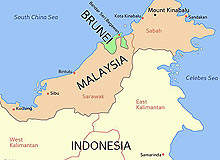
The Sabah-Sarawak Gas Pipeline is part of the Sabah-Sarawak Integrated Oil and Gas project being developed by Petronas, the Malaysian state-owned company.
The integrated project involves the development of offshore oil and gas fields in the Sabah and Sarawak states, and construction of onshore facilities to store, process and transport resources produced from the offshore fields.
The Sabah-Sarawak Gas Pipeline (SSGP) and the Sabah Oil and Gas Terminal (SOGT) comprise the onshore portion of the project.
SOGT is a storage and processing terminal meant for the oil and gas fields offshore of Kota Kinabalu in Sabah. The crude oil and natural gas condensate produced from the offshore fields will reach the SOGT for storage and/or initial processing.
The 512km long SSGP will transport the gas from the SOGT to Petronas’ LNG Complex, at Bintulu in Sarawak, where it will be converted into LNG. The pipeline will run approximately 90km in Sabah and 422km in Sarawak.
The pipeline’s construction was slated for completion by March 2011, but has been progressing behind schedule.
Contractors involved in development
Petronas appointed a consortium led by India-based Punj Lloyd in March 2008 to execute the project.
The consortium partners include Punj Lloyd, Dialog E&C, a subsidiary of the Dialog Group, and Petrosab Logistik, a state-owned unit of Sabah.
The project cost at the time of awarding the contract was estimated to be RM1.6bn ($500m).
The scope of work includes engineering, procurement, construction and commissioning (EPCC) of the pipeline and associated infrastructure.
Designing the pipeline
PL Engineering, a part of Punj Lloyd, was appointed to review and validate the basic engineering and provide detailed engineering for the pipeline and engineering support for the procurement and construction.
Infrastructure of the Sabah-Sarawak gas pipeline
The pipeline will be 36 inches in diameter and will have cathodic protection to control corrosion. A compressor station, a metering station and a receiver station will be built at Bintulu.
A metering station, a compressor and launcher station will be built at Kimanis. Other infrastructure will include intermediate scrapper stations at Lawas and 22 block valve stations. The pipeline will have six tap-off points.
The pipeline assembly will include approximately 44,000 pipes.
Construction of Petronas’ new project
The topography of the proposed pipeline route poses major construction challenges. The terrain along the route is challenging with a mountainous topography, soft and watery soil stretches and nearly 22,000 field bends. Most of the area contains dense rain forest and lacks communication infrastructure.
The topography called for the construction of support infrastructures, such as approach and logging roads, bridges and culverts. In the areas inaccessible by road and rail, the pipes are being transported by air crane helicopters.
The pipeline installation in steep slopes is being carried out using heavy-duty winches and a ropeway crane system. The push-pull method is being adopted in soft and wet areas.
Heavy earth-moving and pipeline equipment are being used in construction on mountainous terrains.
Contracts awarded to companies
Petro-Pipe (Sabah), a unit of Wah Seong, was awarded an RM390m ($123.5m) contract in April 2008 to manufacture, supply, coat and deliver the pipes.
An RM22.9bn ($7.1m) contract to build the compressor station at Bintulu was awarded to Zecon in June 2010. The contractual scope includes the provision of civil, architectural, mechanical and electrical works. An RM8.9bn contract was also awarded to carry out the piling works at the compressor station.
Punj Lloyd awarded a contract to JPAC Technologies to provide a pipeline information management solution (PIMS) for the SSGP.
The PIMS will assist in web-based monitoring of pipeline construction and commissioning.
MIR Valve won a contract from Punj Lloyd to supply 92 actuated ball valves for the SSGP. As part of the contract, MIR Valve will design, manufacture and supply top-entry, side-entry and fully welded ball valve varieties of sizes ranging from two to 36 inches.

